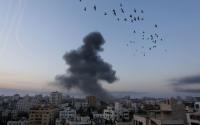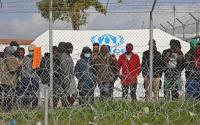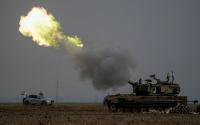The storm-battered Gulf of Mexico is preparing for the latest onslaught as Hurricane Wilma gathers force in the Caribbean, its sights set on the Yucatan peninsula and western Cuba before probably aiming for southern Florida at the weekend.
Wilma, which strengthened within barely 24 hours from a routine tropical storm into a category 5 hurricane with maximum sustained winds of almost 175 miles per hour, is set to provide a fitting finale to what has already been a record Atlantic storm season.
Yesterday morning, the storm's confirmed pressure reading dropped to 882 millibars, the lowest measured for a hurricane in the Atlantic basin.
Temporarily at least, that makes Wilma the most intense hurricane to have formed in the Americas, the previous record-holder being the devastating Labor Day hurricane that struck the Florida Keys in 1935.
The Keys, a fragile string of islands stretching into the Straits of Florida to within 90 miles of Cuba, are again in danger. They are on the more violent, eastern, side of the storm on its projected path towards the densely populated east Florida coast, just north of Miami.
Three days before expected landfall, the authorities were warning people to take precautions and ordering tourists to leave the Keys. After the mayhem already wrought this summer by hurricanes Katrina and Rita, few were in the mood to take chances. Residents were stocking up on tinned food and bottled water and buying boarding to protect windows.
Yesterday, winds stretched out 150 miles from the eye of the storm which is expected to pass between Mexico's Yucatan peninsula and western Cuba tomorrow morning, before turning sharply eastwards and accelerating towards Florida.
Wilma will be the seventh major hurricane to hit the state in the past 16 months. There have been 150 deaths and some $20bn (£11.4bn) in damage, a battering even by Florida's standards.
"Why us?" lamented Governor Jeb Bush, echoing the mood of storm-weary Floridians. "How could the storm take a sharp, 90-degree turn to the east? It's something that we're going to have to live with and prepare for."
Mindful of the lessons of Hurricane Katrina, which devastated New Orleans and Mississippi's Gulf coast on 28 August, US authorities are taking no chances. It is now accepted that only the military has the resources to cope with a major hurricane and the Pentagon has already designated a command centre to handle the aftermath of Wilma.
Most meteorologists say the storm is likely to weaken slightly when a strong front from the north-west pushes it to the east. But even if it hits the US as a category 3 or 4 hurricane, with maximum winds of 130mph and 155mph respectively, it could cause substantial damage.
"This storm will become even larger," Max Mayfield of the National Hurricane Center in Miami said yesterday. "We are expecting a very high storm surge - possibly 15 to 20 feet, especially on the Keys.
"You could compare this to Katrina and Rita. I don't see how the Florida Keys can avoid a major impact."
Cuba has already issued a hurricane watch for the western end of the island from Matanzas to Pinar del Rio, warning of a potentially "catastrophic" storm. Mexico has put almost all its Caribbean coast on alert, including the resort of Cancun.
The one consolation is that by the time it hits southern Florida, Wilma will be moving quickly, reducing the risk of storm flooding. This causes the bulk of the deaths and destruction in a hurricane's wake.
Wilma is the 12th hurricane of the Atlantic season, meaning that 2005 will tie 1969 as the worst since records began in 1851. It is also the season's 21st named storm, equalling the 1933 record, and exhausting this year's alphabetical list of names. Any further storms will be designated by letters of the Greek alphabet, starting with Alpha. Officially, the Atlantic hurricane season does not end until 31 November.
Wilma, which strengthened within barely 24 hours from a routine tropical storm into a category 5 hurricane with maximum sustained winds of almost 175 miles per hour, is set to provide a fitting finale to what has already been a record Atlantic storm season.
Yesterday morning, the storm's confirmed pressure reading dropped to 882 millibars, the lowest measured for a hurricane in the Atlantic basin.
Temporarily at least, that makes Wilma the most intense hurricane to have formed in the Americas, the previous record-holder being the devastating Labor Day hurricane that struck the Florida Keys in 1935.
The Keys, a fragile string of islands stretching into the Straits of Florida to within 90 miles of Cuba, are again in danger. They are on the more violent, eastern, side of the storm on its projected path towards the densely populated east Florida coast, just north of Miami.
Three days before expected landfall, the authorities were warning people to take precautions and ordering tourists to leave the Keys. After the mayhem already wrought this summer by hurricanes Katrina and Rita, few were in the mood to take chances. Residents were stocking up on tinned food and bottled water and buying boarding to protect windows.
Yesterday, winds stretched out 150 miles from the eye of the storm which is expected to pass between Mexico's Yucatan peninsula and western Cuba tomorrow morning, before turning sharply eastwards and accelerating towards Florida.
Wilma will be the seventh major hurricane to hit the state in the past 16 months. There have been 150 deaths and some $20bn (£11.4bn) in damage, a battering even by Florida's standards.
"Why us?" lamented Governor Jeb Bush, echoing the mood of storm-weary Floridians. "How could the storm take a sharp, 90-degree turn to the east? It's something that we're going to have to live with and prepare for."
Mindful of the lessons of Hurricane Katrina, which devastated New Orleans and Mississippi's Gulf coast on 28 August, US authorities are taking no chances. It is now accepted that only the military has the resources to cope with a major hurricane and the Pentagon has already designated a command centre to handle the aftermath of Wilma.
Most meteorologists say the storm is likely to weaken slightly when a strong front from the north-west pushes it to the east. But even if it hits the US as a category 3 or 4 hurricane, with maximum winds of 130mph and 155mph respectively, it could cause substantial damage.
"This storm will become even larger," Max Mayfield of the National Hurricane Center in Miami said yesterday. "We are expecting a very high storm surge - possibly 15 to 20 feet, especially on the Keys.
"You could compare this to Katrina and Rita. I don't see how the Florida Keys can avoid a major impact."
Cuba has already issued a hurricane watch for the western end of the island from Matanzas to Pinar del Rio, warning of a potentially "catastrophic" storm. Mexico has put almost all its Caribbean coast on alert, including the resort of Cancun.
The one consolation is that by the time it hits southern Florida, Wilma will be moving quickly, reducing the risk of storm flooding. This causes the bulk of the deaths and destruction in a hurricane's wake.
Wilma is the 12th hurricane of the Atlantic season, meaning that 2005 will tie 1969 as the worst since records began in 1851. It is also the season's 21st named storm, equalling the 1933 record, and exhausting this year's alphabetical list of names. Any further storms will be designated by letters of the Greek alphabet, starting with Alpha. Officially, the Atlantic hurricane season does not end until 31 November.






